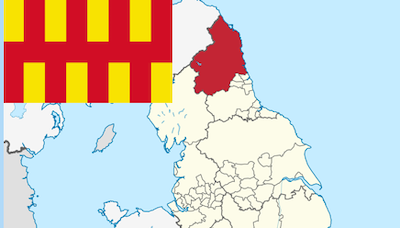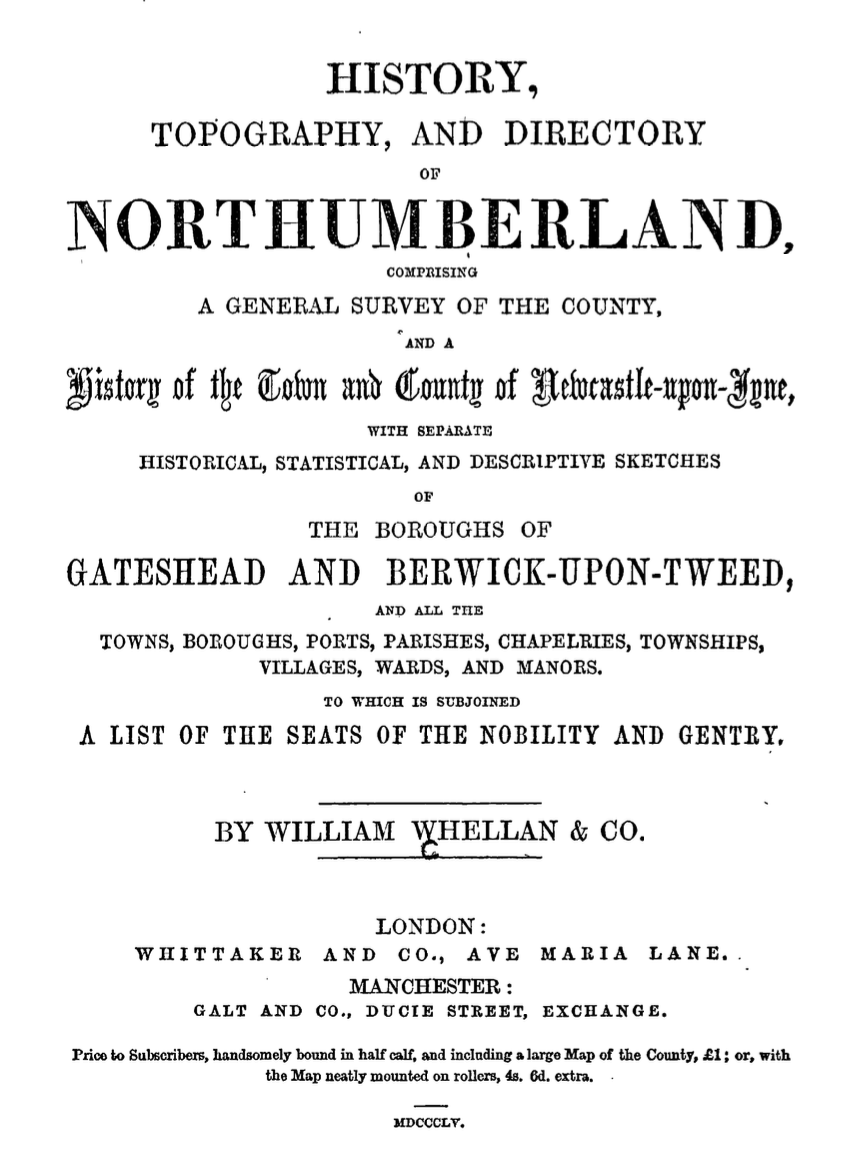Topics > Northumberland > Civil Parishes in Northumberland > Chatton Civil Parish > Chatton Parish, 1855
Chatton Parish, 1855
Extract from: History, Topography, and Directory of Northumberland...Whellan, William, & Co, 1855.
CHATTON PARISH
CHATTON parish is bounded on the north by Lowick and Doddington parishes, on the west by Wooler and Eglingham, on the south by Eglingham and Chillingham, and on the east by Bambrough and Belford parishes. It is about seven and a half miles in length by the same in breadth, and has an area of 17,090 acres. Population in 1801, 1135; in 1811, 1,378; in 1821, 1,460; in 1831, 1,632; in 1841, 1,725; and in 1851, 1,765 souls, It comprises the townships of Chatton, Coldmartin, Fowberry, Hazelrig, Hetton, Hetton House, Horton, Lyham, and Weetwood, whose returns are included in those of the parish. This district is intersected by the river Till, a rapid stream, which rises southward of the Cheviot Hills, and is fed by various springs from that wild expanse of country, as it encompasses it at a considerable distance, till it falls into the Tweed, below Cornhill. This river flows through a pleasant valley in the midst of a rude, encircling waste, and its banks are adorned by several villages. In the neighbourhood of the Till, the soil is fertile and well cultivated, but the east and west portions of the parish are generally sterile and heathy. Coal and limestone are found in this district.
CHATTON, a township and village in the parish of the same name, is the property oi the Duke of Northumberland, who is also lord of the manor. THE VILLAGE of Chatton is situated near the river Till, four miles east of Wooler. THE CHURCH, dedicated to the Holy Cross, is a neat modern edifice, erected in 1763, and the parish register commences in 1715. The living is vicarage in the archdeaconry, of Lindisfarne and deanery of Norham, rated in the Liber Regis at £12 6s. ½d.; gross income £199. Patron, the Duke of Northumberland; the vicar, the Rev, Matthew Burrell. In March 1814, as the sexton was digging a grave on the north side of Chatton Church, he found a stone coffin, containing the remains of a human body, about ten inches below the surface. It was secured and neatly covered with three stones. The skull was almost perfect, hut nearly full of water, and the teeth of the upper jaw were a full set; the thigh bone measured eighteen inches. The earth being carefully examined, one of Robert Bruce's silver pennies was found, as also a steel spur, and several relics of ornamental brass and iron-work, supposed to be the remains of the helmet of the warrior who had been interred in the coffin. The Rev. Joseph Cook, of Newton Hall, vicar of Chatton, offers the following remarks on the discovery of this ancient stone coffin. "In 1318 Robert Bruce and his adherents had been excommunicated by the Pope for contumacy to the messengers of his holiness, and having assaulted and taken the fortress of Berwick, as well as the Castles of Wark, Harbottle, and Mitford, and laid waste all the intervening country, it is probable that the warrior now alluded to, fell at this juncture, and that the vicar of Chatton, on the strength of the above-named anathema, refused sepulture to his remains in any other part of the consecrated ground, than that of the north side of the church, the place in those times allotted, I believe, for the unhallowed interment of excommunicated unfortunates.''
POST OFFICE, CHATTON.-Robert Tindall, Postmaster. Letters arrive at 2·0 p.m., and are despatched at 4-0 p.m.
|
Beattie William, mason Brown Jane, shopkeeper Burrrll Rev. Matthew, vicar Crinkley Barbara, shopkeeper Colevin William, tailor Davison Ann, shopkeeper Donaldson Joseph, schoolmaster Douglas John, tailor Douglas Mary, vict. Boot Gibbison Thomas, shopkeeper Gibson George, shopkeeper Hall R. & Co. brick and tile manufacturers Henderson Thomas, vict. brewer and malster, Woolsingham Bell Jobson Robert, gardener Jobson William, boot and shoemaker Muckle Charles, mason Muckle John, tailor Muckle Bobert, tailot Nesbit James, baker Patterson William, mason Pyle George, blacksmith |
Pringle William, mason Rogers Miss Elizabeth Rogers Nicholas, nursery and seedsman Taylor William, saddler Tate James, shopkeeper Tindall Robert, grocer and draper Wood John, butcher Wilson John, joiner Young Rev. David, (Presbyterian)
Farmers Anderson George Chartres Thomas, Reddish Hall Dixon Edward, Sandyford Douglas Mary Gilholm Edward, Bridge Farm Laidler Thomas, Henlaw Maddison Thomas, Wandon, Fowberry New Hall, and Blakelaw Marshall John, Chatton Park Pyle George Rogers Nicholas, Ammerside Law Tindall John, and. miller, Broom House |
COLDMARTIN township is situated one mile south-east of Wooler, and the principal residents are Richard Henderson, farmer ; Christopher Hopper ; and Elizabeth Millican, farmer.
FOWBERRY is a township two miles east by south of Wooler, the property of George Cully, Esq., of Fowberry Tower. This place was the manor and estate of William de Fowberry, in the reign of Edward I., of Robert de Fowberry, in the time of Edward IV., and of William de Fowberry, in 1524. From the Fowberry's, it passed to the Strothers, of Kirk Newton, and about eighty years ago became the property of the family of the present proprietor. FOWBERRY TOWER, the residence of George Culley, Esq., is pleasantly and romantically situated on the south bank of the Till.
DIRECTORY. George Culley, Esq., Fowberry Tower ; Richard Beattie, mason; Mrs. Helen Darling, Fowberry Tower ; Andrew Steel, blacksmith ; Mr. Edward Johnson, Clavering's Cottage; and the farmers are Margaret Clark, Moor; James Moffitt, Fowberry Main; and J. A. and J. Robinson.
HAZELRIG township, the property of Lady Stanley, and the executors of William Bayley, Esq., is situated six miles north-east of Wooler, and its principal inhabitants are George Johnson, schoolmaster; James Purvis, blacksmith; and the farmers are George Davison, South Hazelrig; Alexander Ford, and corn miller, Hazelrig Mill ; and William Nicholson, North Hazelrig.
HETTON township is situated five miles N.N.E. of Wooler, and is the property of Fairfax Fearnley, Esq. It contains the small hamlets called Hetton-Law, Hetton Steads, Coal Houses, and Crook Houses. The principal residents are John Cuthbertson, joiner, cartwright, and farmer, Coal-Law; Robert Bowie, farmer, coalowner, and limeburner, Hetton-Caw, and Crook House; James Henry, blacksmith; Thomas Henry, farmer, Coal House; and Thomas and Ralph Moffett, farmers, Hetton Steads.
HETTON HOUSE, a small township three and a half miles E.N.E. of Wooler, is the property of George Culley, Esq., and is occupied by Richard Henderson, farmer.
HORTON is a township and hamlet the property of George Culley, Esq. This estate was formerly held of the barony of Vesci, for half a Knight's fee, by William de Tuberville, and it afterwards became the property of a junior branch of the Greys of Chillingham, coming ultimately into the possession of the present proprietor. Of the once strong castle of Horton scarcely a vestige now remains .THE HAMLET of Horton is situated three miles north-east of Wooler.
DIRECTORY. - Mrs. Mary Ann Berwick; Edward Lillie, blacksmith; and William Turnbull, farmer.
LYHAM township is situated six miles E.N.E. of Wooler. The principal residents are Thomas Aitchison, farmer; Ralph Craig, farmer, North Lyham; and David Turnbull, farmer, West Lyham.
WEETWOOD is a township situated two miles north-east of Wooler. An annual fair is held at Weetwood Bank, on Whit Tuesday, when there are very large shows of cattle, horses, and sheep. Servants are also hired at this fair. WEETWOOD HALL, the seat of Major Ord, is pleasantly situated on the north bank of the Till.
DIRECTORY. Major John B. Ord, Weetwood Hall; and the farmers are George Bone, Weetwood Hill; and Thomas F. Ord, Weetwood Hall.










